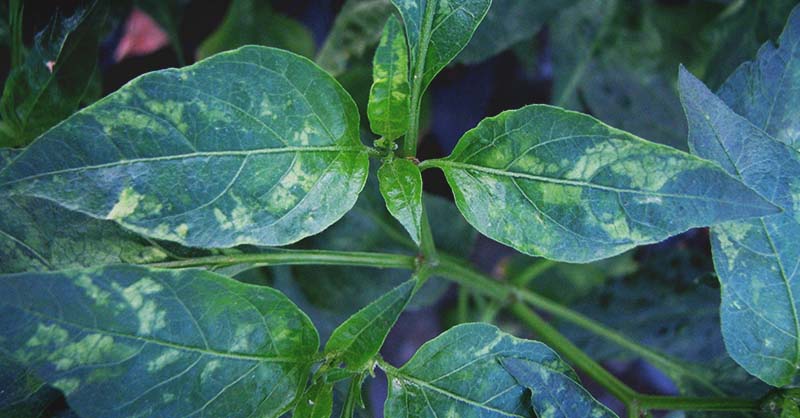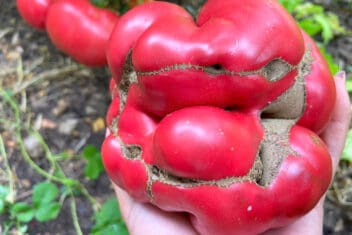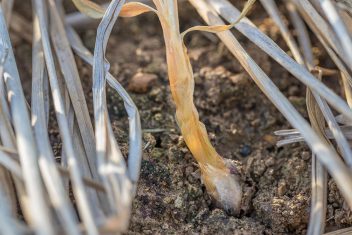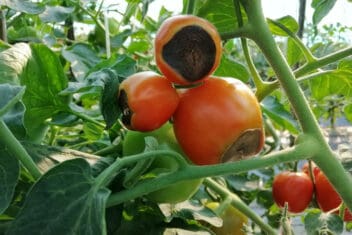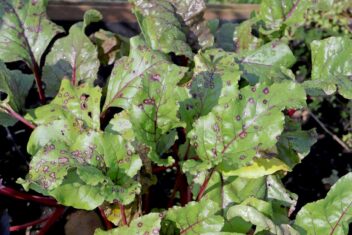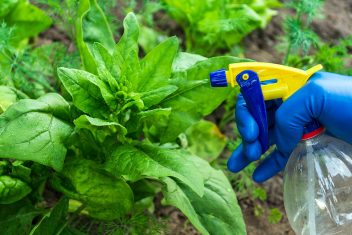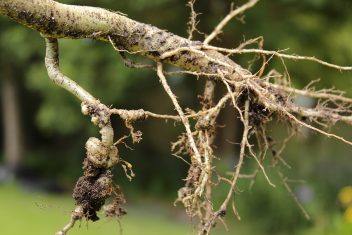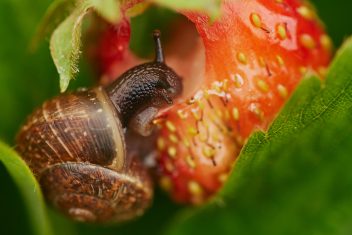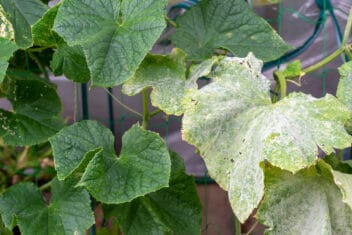The Tobacco Mosaic Virus or TMV is the first plant virus ever identified. Although it wasn’t labeled as a virus until 1930, it has plagued tobacco farmers since the late 1800s to present. Despite its name, this “tobacco” virus can infect over 350 different plant species, many of which are favorites in home gardens such as tomatoes and potatoes.
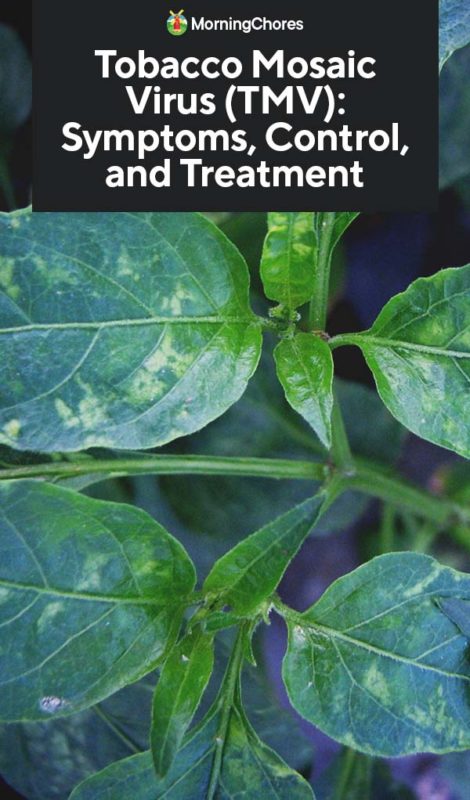
About Tobacco Mosaic Virus (TMV)
TMV usually doesn’t kill the host plant outright. Depending on when the virus is contracted, some infected plants may even go on to produce fairly. TMV typically slows plant growth by stunting leaves and limiting photosynthesis. It can also make infected plants more susceptible to other pests and diseases.
Unfortunately, when it infects young plants or is inadvertently spread to many plants in your garden, it can really impact your overall harvest. Also, like most viruses, TMV currently has no cure. Prevention and management are the only available tools to stave off harvest losses from TMV.
Understanding how this virus is transmitted, how it infects plants, ways to limit your risks, and effectively managing outbreaks can help keep this virus in check. Let’s take a closer look at how this virus operates and ways to minimize risks and potential damage.
Tobacco Mosaic Virus Symptoms
Tobacco Mosaic Virus can be easily recognized by a mottled discoloration on plant leaves. Yellow or pale green and darker green coloration intermixed on the leaf surface, making it look a bit like a pointillist painting. The leaves may also scald on hot days creating brown or dead spots on leaves.
Sometimes the plant veins will appear to yellow first. The leaves may also be malformed, often appearing more rounded than their healthy counterparts. Growing tips may be stunted first. On grasses, TMV can appear as yellow streaks mixed with bits of green.
Unfortunately, TMV is easy to confuse with chlorosis caused by nutrient deficiencies, other viruses such as tomato mosaic virus (ToMV), and occasionally with insect issues. It can also be difficult to spot TMV on young plants.
For an absolute diagnosis, plant tissue samples must be tested at a lab. Alternatively, you can contact your local agricultural extension office for assistance. However, even in the absence of absolute diagnoses, if you suspect your plants might be infected with TMV, taking steps to control the possible spread of the virus is the safest course of action for your garden.
Plants at Risk for TMV
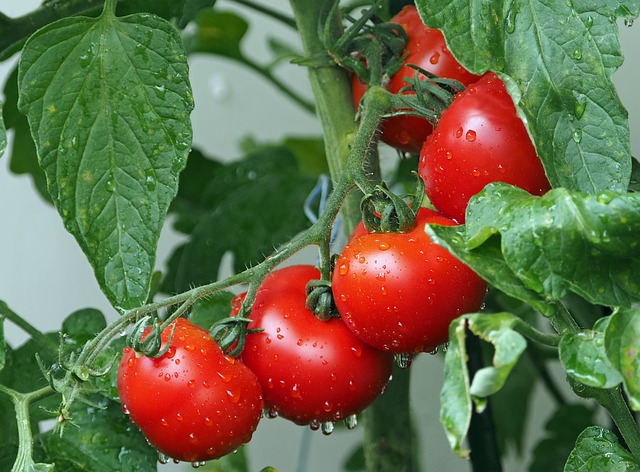
As mentioned earlier, over 350 species of plants can potentially be impacted by TMV. However, to the home gardener, the biggest risks are to the edible members of the Solanaceae plant family, also called nightshades.
Nightshade or Solanaceae
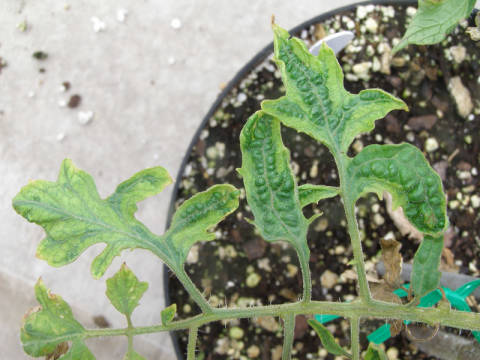
This family of plants includes tomato, potato, eggplant, and peppers which are staples of most gardens. It also includes less common, but still often found options like ground cherries, tomatillos, goji berry, and garden huckleberry. Tobacco, as the name implies, is also highly susceptible to TMV.
Notably, tamarillo (the tree tomato) which is growing in popularity in home gardens, seems to have a natural resistance to TMV. Also some popular commercial plant varieties, like ‘Big Beef’ and ‘Celebrity’ tomatoes, are sold specifically for their TMV resistance. Before you assume TMV is your culprit, check with your seed or plant provider to find out of your plants are susceptible.
Other Cultivated Plants At Risk for TMV
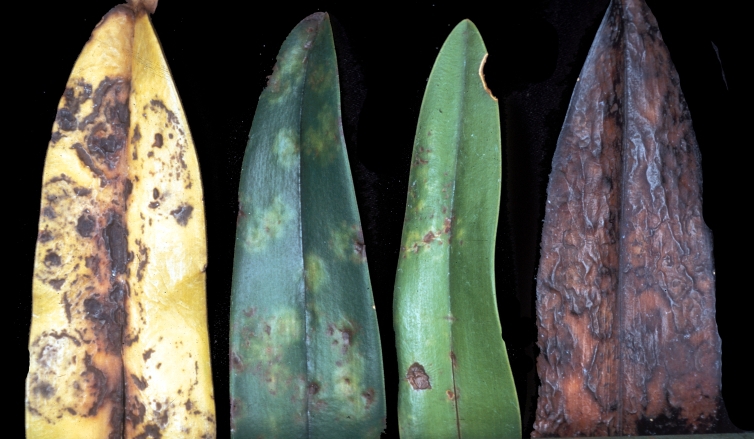
Besides nightshade family plants, many other common garden plants can be harmed by TMV. Amaranth, apples, beans, beets, buckwheat, calendula. carrots, chrysanthemums, cowpeas, currants, delphiniums, daisies, grapevine, French marigold, mustards, New Zealand spinach, orchids, pear, petunia, spinach, sunflowers, turnips, verbena, and zinnia are just a few of the 350+ plants that are at risk for TMV.
Marijuana, which is not legal to grow in most gardens (yet), is also believed to be impacted by TMV. Hemp plants grown for food and fiber, which are also highly regulated, may also be negatively impacted by TMV.
Weeds At Risk for TMV
Additionally, many common garden weeds such as black nightshade, plantain, chickweed, jimsonweed, henbit, horsenettle, knotweed, lambsquarters, pigweed, pokeweed, purslane, and smartweed are all possible hosts for TMV.
Even though you aren’t likely worried about the productivity of these weeds, they can transmit the virus to domesticated garden plants through proximity. As such, you’ll want to monitor your weeds for viral invasions as well.
Life Cycle of TMV
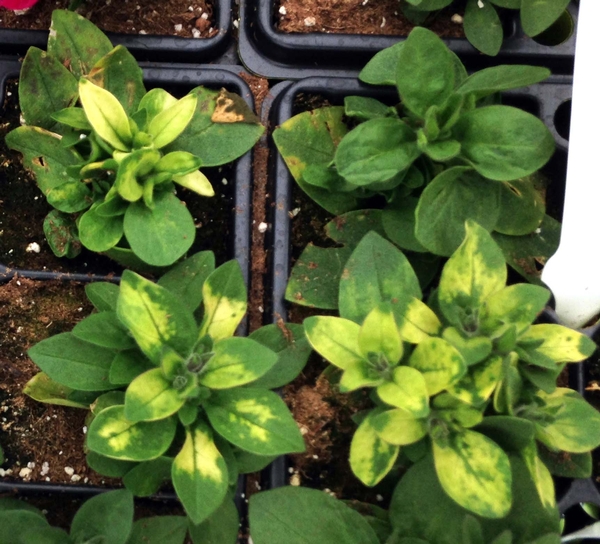
Photo credit: Heidi Wollaeger, Michigan State University Extension
The basic life cycle of the virus is very much like the common cold. The virus can be passed from host to host or by mechanical transmission. Once the virus makes contact with a suitable host plant, it begins to replicate itself using the host plant’s cells.
Start of Symptoms
At about 10 days after infection, the host will begin showing signs and symptoms of infection such as mottled coloration on leaves and stunting. In young plants, the signs may be slower to manifest but the impacts of the virus will likely be greater. When mature plants become infected, if they are in good health, they may still produce a fair harvest.
TMV Resistance
In plants that are resistant to TMV, the virus will not be able to replicate itself. There are various levels of resistance in plants. Some are fully resistant. Some are slower to replicate TMV and may not show as many symptoms.
Persistence in the Environment
Unlike the common cold though, the virus can remain dormant in dried plant parts for over 50 years. It can also remain viable in wet plant material (e.g. decomposing in a compost pile or in moist soil) for 1-2 years.
If the virus makes contact with another host plant while it is still viable, then it can begin the cycle again.
Vectors of Transmission
Since TMV occurs widely in dried tobacco leaves used for smoking or chewing, even flicking a partially smoked cigarette or spitting a wad of chew near a garden could lead to the virus being spread through the garden.
– Mechanical Transmission
In fact, the most common means of transmission of TMV is not plant to plant, but mechanically from either tools or people to plants. For example, a smoker gets the virus on their hands and then prunes a tomato plant. Or, infected plants are harvested by a machine that is then used in another field. Someone walks through a patch of weeds with TMV and carries it back to their garden on the soles of their shoes.
– Plant Residues
Additionally, if plant residues are tilled into the soil, the virus can live on in the plant matter until it is fully decomposed. In some cases, this means the virus can even overwinter and be viable again when the next crop is planted.
– Insect Transmission
Some researchers say that insects such as aphids may be vectors of transmission for TMV, particularly in greenhouse settings. Other sources indicate that insects are not a known source of transmission for TMV.
Although insect transmission is not a primary source for the spread of the virus, it is something to keep in mind.
Control Methods for TMV
There are no chemical solutions for treating TMV after it infects your plants. Prevention through good biological practices and rapid response to infection is key to controlling this garden problem.
Prevention:
There are many ways to reduce your risk of battling TMV in your garden.
1. Crop Rotation
Plants that are highly susceptible to TMV such as non-resistant tomato varieties should not be planted in the same bed for at least 2 years.
2. Remove Crop Residues
If you grow plants at risk for TMV, even if you don’t believe they are infected, remove your crop residues from your garden beds to reduce risk. Rather than tilling in plant residues, hot compost them. Then, ensure the ideal moisture rate of 60% during decomposition, and age your compost for 1-2 years to prevent possible contact with infected undecomposed plant matter.
3. No Smoking Policy
Non-smoking or chewing policies are not just great for your health, but also for the health of your garden. By keeping dried tobacco away from your garden, you can reduce your risk of transmission.
4. Good Sanitation
Use a bleach solution of nine parts water to one part bleach as a tool dip between plants. Allow the tools to soak for one minute. Alternatively, you can dip tools in a mix of one part nonfat milk to four parts water for one minute.
Wash your hands vigorously with soap and warm water for at least 30 seconds if you come into contact with infected plants.
5. Control Susceptible Weeds
Weeds that are prone to catching TMV should be kept under control in the garden to reduce the potential for plant-to-plant transmission.
6. Avoid Monocultures
If you plant lots of the susceptible plants in a patch, the virus can spread quickly from plant to plant. If you space plants out and interplant with non-susceptible varieties, you can reduce the risk for quick transmission.
7. Disease-Free Plants
Buy seeds or plants that are certified disease-free or TMV resistant. Disease-free seeds need to be fermented, dried at a temperature of 125º F, and preferably saved for 1-2 years before planting to ensure the virus is no longer viable in the seeds. Plants should come from certified seeds and be grown in sterile planting medium.
8. Resistant Plants
Consider choosing hybrid or naturally resistant plant varieties to plant if you might be at greater risk for TMV infection. For example, many tomato or tobacco farmers have shifted to TMV resistant seeds. Also, greenhouses seem to be particularly susceptible to TMV, so resistant plants are a good option for indoor growing.
9. Seed and Seedling Pre-Treatment
Research has shown that skim milk washes or trisodium phosphate solution can inhibit the virus when applied to seeds and seedlings.
For treating seeds, soak them in a 10% solution of trisodium phosphate for at least 15 minutes. Trisodium phosphate ( (Na3PO4) is a very strong cleaning product additive that can be purchased from online retailers. Use caution when handling.
You can also use one part skim milk to four parts water and spray seedlings until they are saturated. This has been shown to inhibit the virus when used on young seedlings.
Post-Infection Treatment:
If you have identified or suspect you have TMV in plants consider the following options.
10. Removal
Entirely remove the plant and roots, placing them carefully inside a sealed plastic bag to avoid contaminating other plants. Send the sealed bag to the landfill or burn or hot compost the plant matter and disinfect the bag prior to re-use with nine parts water to one part bleach.
11. Delayed Removal
If your plants are still productive, it can be hard to remove them. Quite frankly, in many commercial environments, plants are allowed to produce at lower rates rather than lose the entire harvest as a standard practice. However, as long as infected plants remain in the garden, they are a potential risk for transmission to your other plants.
If you don’t plan to immediately remove the plants, then use extra sanitation measures to reduce the risk of spreading the virus. For example, wash your hands after you harvest or otherwise handle an infected plant. Use dedicated gloves for potentially infected plants. Sanitize not only blades but handles of garden tools.
Although TMV is not primarily transmitted by insects, unhealthy plants are more prone to pest pressure. Consider using row covers to prolong the life of your plants and eliminate the possible risk of pest cross-infection.
12. Skip Seed Saving
Do not save seeds from plants that might potentially be infected. Even with fermentation and appropriate drying and storing procedures, the seeds could be a source of future infection. Don’t risk it.
13. Save Other Gardens
Many of us gardeners share our harvests and our overstock on plants. If you have issues with TMV in your garden, warn other gardeners before sharing. Even if they still want your extra tomatoes, at least they will be forewarned to take extra precautions in processing. Plus, they won’t be tempted to save the seeds.
14. Skip a Year
If you have strains of TMV that are particularly bad for certain vegetables or plants, take a year off from those plants entirely. Then, add extra compost to your garden to speed the decomposition of any plant residues.
15. Switch Varieties
Once TMV is in your garden, you can reduce its long-term impact by switching your planting line-up to TMV-resistant varieties for two years to let the disease time-out in your garden.
16. Soil Swap
Temporarily using gardening methods like square foot gardening where you start your garden with brand new soil, can give you a fresh start. By bringing in new soil that does not contain crop residues from TMV infected plants, you can better limit risks for reinfection.
Conclusion
Tobacco mosaic virus is found all over the world and can be hard to avoid. The reality is that many long-term gardeners will face TMV at some point.
Being proactive, managing risks, and reacting quickly before TMV takes over your garden are your best options for avoiding harvest losses. Now, with 15 ways to prevent and proactively respond to TMV in your repertoire, you are ready to meet the challenge should the need arise.
References
- https://extension.psu.edu/tobacco-mosaic-virus-tmv
- https://en.wikipedia.org/wiki/Tobacco_mosaic_virus https://projects.ncsu.edu/cals/plantpath/extension/clinic/fact_sheets/index.php?do=disease&id=19
- https://extension.umn.edu/diseases/tomato-mosaic-virus-and-tobacco-mosaic-virus
- https://www.crfg.org/pubs/ff/tamarillo.html
- https://www.growweedeasy.com/tobacco-mosaic-virus-tmv-cannabis
- https://ipm.illinois.edu/diseases/rpds/917.pdf
- https://extension.wsu.edu/snohomish/tobacco-mosaic/
- https://www.canr.msu.edu/news/common_question_and_answers_about_tobacco_mosaic_virus

